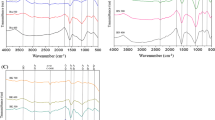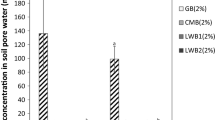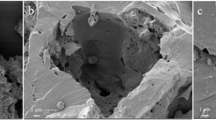Abstract
In contaminated soils, excessive concentrations of metals and their high mobility pose a serious environmental risk. A suitable soil amendment can minimize the negative effect of metals in soil. This study investigated the effect of different biochars on metal (Cu, Pb, Zn) immobilization in industrial soil. Biochars produced at 300 and 600 °C from conventional (MS, maize silage; WP, wooden pellets) and alternative (SC, sewage sludge compost; DR, digestate residue) feedstocks were used as soil amendments at a dosage of 10 % (w/w). The type of feedstock and pyrolysis temperature affected the properties of the biochars and their ability to immobilize metal in soil. Compared to production at 300 °C, all biochars produced at 600 °C had higher pH (6.2–10.7), content of ash (7.2–69.0 %) and fixed carbon (21.1–56.7 %), but lower content of volatile matter (9.7–37.2 %). All biochars except DR biochar had lower dissolved organic carbon (DOC) content (1.4–2.3 g C/L) when made at 600 °C. Only MS and SC biochars had higher cation exchange capacity (25.2 and 44.7 cmol/kg, respectively) after charring at 600 °C. All biochars contained low concentrations of Cd, Cu, Ni, Pb and Zn; Cd was volatilized to the greatest extent during pyrolysis. Based on FTIR analysis and molar ratios of H/C and O/C, biochars had a greater degree of carbonization and aromaticity after charring at 600 °C. The efficiency of the biochars in metal immobilization depended mainly on their pH, ash content, and concentration of DOC. SC and DR biochars were more effective for Cu and Zn immobilization than MS and WP biochars, which makes them attractive options for large-scale soil amendment.




Similar content being viewed by others
References
Ahmad M, Rajapaksha AU, Lim JE, Zhang M, Bolan N, Mohan D, Vithanage M, Lee SS, Ok YS (2014) Biochar as a sorbent for contaminant management in soil and water: a review. Chemosphere 99:19–33
Al-Wabel MI, Al-Omran A, El-Naggar AH, Nadeem M, Usman AR (2013) Pyrolysis temperature induced changes in characteristics and chemical composition of biochar produced from conocarpus wastes. Bioresour Technol 131:374–379
Bahng MK, Donohoe BS, Nimlos MR (2011) Application of an Fourier transform infrared imaging tool for measuring temperature or reaction profiles in pyrolyzed wood. Energ Fuel 25:370–378
Barneto AG, Carmona JA, Jesús Díaz Blanco M (2010) Effect of the previous composting on volatiles production during biomass pyrolysis. J Phys Chem A 114:3756–3763
Beesley L, Moreno-Jiménez E, Gomez-Eyles JL (2010) Effects of biochar and greenwaste compost amendments on mobility, bioavailability and toxicity of inorganic and organic contaminants in a multi-element polluted soil. Environ Pollut 158:2282–2287
Bolan N, Kunhikrishnan A, Thangarajan R, Kumpiene J, Park J, Makino T, Kirkham MB, Scheckel K (2014) Remediation of heavy metal(loid)s contaminated soils – to mobilize or to immobilize? J Hazard Mater 266:141–166
Brick S (2010) Biochar: assessing the promise and risks to guide US policy. Natural Resource Defense Council, USA
Calvelo Pereira R, Kaal J, Camps Arbestain M, Pardo Lorenzo R, Aitkenhead W, Hedley M, Macías F, Hindmarsh J, Maciá-Agulló JA (2011) Contribution to characterisation of biochar to estimate the labile fraction of carbon. Org Geochem 42:1331–1342
Cao XD, Harris W (2010) Properties of dairy-manure-derived biochar pertinent to its potential use in remediation. Bioresour Technol 101:5222–5228
Chen B, Zhou D, Zhu L (2008) Transitional adsorption and partition of nonpolar and polar aromatic contaminants by biochars of pine needles with different pyrolytic temperature. Environ Sci Technol 42:5137–5143
CLARINET (2002) Brownfields and Redevelopment of Urban Areas, Federal Environment Agency, Austria, On line:http://www.commonforum.eu/Documents/DOC/Clarinet/brownfields.pdf
Czekała W, Pilarski K, Dach J, Janczak D, Szymańska M (2012) Analysis of the possibilities of anaerobie digestate management from biogas plant. Agr Hortic Forest Eng 4:6–8 in Polish
Dybowska A, Farago M, Valsami-Jones E, Thornton I (2006) Remediation strategies for historical mining and smelting sites. Sci Prog 89:71–138
Enders A, Hanley K, Whitman T, Joseph S, Lehmann J (2012) Characterization of biochars to evaluate recalcitrance and agronomic performance. Bioresour Technol 114:644–653
Gaskin J, Steiner C, Harris K, Das K, Bibens B (2008) Effect of low-temperature pyrolysis conditions on biochar for agricultural use. Trans ASABE 51:2061–2069
Gusiatin ZM, Bułkowska K, Pokój T (2014) Tannic acid as a cost-effective substitute for saponin in soil remediation. Environ Biotech 10:66–72
Hossain MK, Strezov V, Chan KY, Ziolkowski A, Nelson PF (2011) Influence of pyrolysis temperature on production and nutrient properties of wastewater sludge biochar. J Environ Manag 92:223–228
Houben D, Evrard L, Sonnet P (2013) Mobility, bioavailability and pH-dependent leaching of cadmium, zinc and lead in a contaminated soil amended with biochar. Chemosphere 92:1450–1457
Jassal RS, Johnson MS, Molodovskaya M, Black TA, Jollymore A, Sveinson K (2015) Nitrogen enrichment potential of biochar in relation to pyrolysis temperature and feedstock quality. J Environ Manag 152:140–144
Jindo K, Mizumoto H, Sawada Y, Sanchez-Monedero MA, Sonoki T (2014) Physical and chemical characterization of biochars derived from different agricultural residues. Biogeosciences 11:6613–6621
Jung S-H, Kim J-S (2014) Production of biochars by intermediate pyrolysis and activatedcarbons from oak by three activation methods using CO2. J Anal Appl Pyrolysis 107:116–122
Karczewska A (1996) Metal species distribution in top- and sub-soil in an area affected by copper smelter emissions. Appl Geochem 11:35–42
Karczewska A, Gałka B, Kabała C, Szopka K, Kocan K, Dziamba K (2009) Effects of various chelators on the uptake of Cu, Pb, Zn and Fe by maize and indian mustard from silty loam soil polluted by the emissions from copper smelter. Fresen Environ Bull 18:1967–1974
Keiluweit M, Nico PS, Johnson MG, Kleber M (2010) Dynamic molecular structure of plant biomass-derived black carbon (biochar). Environ Sci Technol 44:1247–1253
Kulikowska D, Klimiuk E (2011) Organic matter transformations and kinetics during sewage sludge composting in a two-stage system. Bioresour Technol 102:10951–10958
Koukios EG (1993) Progress in thermochemical, solid-state refining of biomass – from research to commercialization. In: Bridgwater AV (ed) Advances in thermochemical biomass conversion, 1st edn. Springer Science + Business Media Dordrecht, Netherlands, pp. 1678–1692
Lou R, Wu S-B, Lv G-J, Guo D-L (2010) Pyrolytic products from rice straw and enzymatic/mild acidolysis lignin (EMAL). Bioresources 5:2184–2194
Luo F, Song J, Xia W, Dong M, Chen M, Soudek P (2014) Characterization of contaminants and evaluation of the suitability for land application of maize and sludge biochars. Environ Sci Pollut Res Int 21:8707–8717
Mahmoud AH, Saleh ME, Abdel-Salam AA (2011) Effect of rice husk biochar on cadmium immobilization in soil and uptake by wheat plant grown on lacustrine soil. Alex J Agric Res 56:117–125
Masia AAT, Buhre BJP, Gupta RP, Wall TF (2007) Characterizing ash of biomass and waste. Fuel Process Technol 88:1071–1081
Meng J, Wang L, Liu X, Wu J, Brookes PC, Xu J (2013) Physicochemical properties of biochar produced from aerobically composted swine manure and its potential use as an environmental amendment. Bioresour Technol 142:641–646
Mohan S, Gandhimathi R (2009) Removal of heavy metal ions from municipal solid waste leachate using coal fly ash as an adsorbent. J Hazard Mater 169:351–359
Naeem MA, Khalid M, Arshad M, Ahmad R (2014) Yield and nutrient composition of biochar produced from different feedstocks at varying pyrolytic temperatures. Pak J Agri Sci 5:75–82
Nansubuga I, Banadda N, Ronsse F, Verstraete W, Rabaey K (2015) Digestion of high rate activated sludge coupled to biochar formation for soil improvement in the tropics. Water Res 81:216–222
Novak JM, Lima I, Xing B, Gaskin JW, Steinem C, Das KC, Ahmedna M, Rehrah D, Watts DW, Busscher WJ, Schomberg H (2009) Characterization of designer biochar produced at different temperatures and their effects on a loamy sand. Ann Environ Sci 3:195–206
OMARD (2004) Ordinance of the minister of agriculture and rural development on fertilizers and fertilization. J Law 236:16834–16839 in Polish
OMARD (2008) Ordinance of the minister of agriculture and rural development on fertilizers and fertilization. J Law 119:6515–6520 in Polish
OME (2002) The ordinance of the Ministry of Environment on soil quality. J Law 165:10561–10564 (in Polish)
Ostrowska A, Gawliński S, Szczubiałka Z (1991) Methods of analysis and assessment of soil properties and plants. Institute of Environmental Protection, Warsaw, Poland in Polish
Pellera FM, Giannis A, Kalderis D, Anastasiadou K, Stegmann R, Wang JY, Gidarakos E (2012) Adsorption of Cu(II) ions from aqueous solutions on biochars prepared from agricultural by-products. J Environ Manag 96:35–42
Pérez-Esteban J, Escolástico C, Masaguer A, Moliner A (2012) Effects of sheep and horse manure and pine bark amendments on metal distribution and chemical properties of contaminated mine soils. Eur J Soil Sci 63:733–742
Schmidt HP, Abiven S, Kamman C, Glaser B, Bucheli T, Leifield J (2012) Guidelines for biochar production: European biochar certificate version 4.2. Delinat Institute und Biochar Science Network
Scoullos M (2000) Data and trends on cadmium. Synopsis prepared as a background document for the International EUPHEMET’s Workshop (Toward an Integrated EU Policy for Heavy Metals), Athens, Greece
Srinivasan P, Sarmah AK (2015) Characterisation of agricultural waste-derived biochars and their sorption potential for sulfamethoxazole in pasture soil: a spectroscopic investigation. Sci Total Environ 502:471–480
Uchimiya M, Orlov A, Ramakrishnan G, Sistani K (2013) In situ and ex situ spectroscopic monitoring of biochar’s surface functional groups. J Anal Appl Pyrolysis 102:53–59
Vassilev SV, Baxter D, Andersen LK, Vassileva CG (2010) An overview of the chemical composition of biomass. Fuel 89:913–933
Wilding LP, Brown RE, Holowaychuk N (1969) Asccesibility and properties of occluded carbon in biogenetic opal. Soil Sci 103:56–61
Yargicoglu EN, Sadasivam BY, Reddy KR, Spokas K (2015) Physical and chemical characterization of waste wood derived biochars. Waste Manag 36:256–268
You S-J, Lee S-Z, Allen HE, Yin Y (2001) Determinants of metal retention to and release from soils. In: Iskandar IK (ed) Environmental restoration of metals-contaminated soils. CRC Press LLC, pp 77–91
Zhang Y, Luo W (2014) Adsorptive removal of heavy metal from acidic wastewater with biochar produced from anaerobically digested residues: kinetics and surface complexation modeling. Bioresources 9:2484–2499
Zhang J, Liu J, Liu R (2014) Effect of pyrolysis temperature and heating time on biochar obtained from the pyrolysis of straw and lignosulfonate. Bioresour Technol 176:288–291
Acknowledgments
This work was supported by the Faculty of Environmental Sciences, University of Warmia and Mazury in Olsztyn, Poland (No. GW/2014/24). The authors thank the Director of Legnica Copper Smelter and Refinery for permission to collect and use soil samples and to publish the results.
Author information
Authors and Affiliations
Corresponding author
Additional information
Responsible editor: Hailong Wang
Rights and permissions
About this article
Cite this article
Gusiatin, Z.M., Kurkowski, R., Brym, S. et al. Properties of biochars from conventional and alternative feedstocks and their suitability for metal immobilization in industrial soil. Environ Sci Pollut Res 23, 21249–21261 (2016). https://doi.org/10.1007/s11356-016-7335-4
Received:
Accepted:
Published:
Issue Date:
DOI: https://doi.org/10.1007/s11356-016-7335-4




